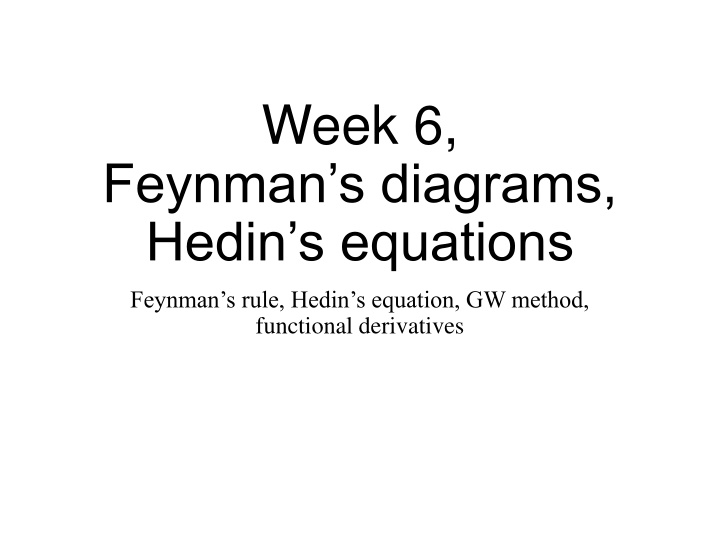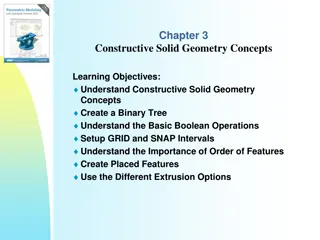
Understanding Feynman's Diagrams, Hedin's Equations, and the GW Method
Explore the concepts of Feynman's diagrams, Hedin's equations, and the GW method in theoretical physics. Learn about fundamental interaction vertices, self-energy, Dyson equations, and the GW approximation. Discover the application of density functional theory and the derivation of Hedin's equations.
Download Presentation

Please find below an Image/Link to download the presentation.
The content on the website is provided AS IS for your information and personal use only. It may not be sold, licensed, or shared on other websites without obtaining consent from the author. If you encounter any issues during the download, it is possible that the publisher has removed the file from their server.
You are allowed to download the files provided on this website for personal or commercial use, subject to the condition that they are used lawfully. All files are the property of their respective owners.
The content on the website is provided AS IS for your information and personal use only. It may not be sold, licensed, or shared on other websites without obtaining consent from the author.
E N D
Presentation Transcript
Week 6, Feynman s diagrams, Hedin s equations Feynman s rule, Hedin s equation, GW method, functional derivatives
Feynmans rule for G ????,? = ???? ?1,?2 = ????,? = ?,? ?,? ?,?1 ?,?2 The ?-th order expansion has n interaction lines ? (- - - - ), and 2? + 1 green s functions ? ( ), each interaction vertex contributes an ? (charge of an electron) The diagrams must be connected and topologically distinct (connected in different ways) The ?-th order diagram has a pre-factor of ? ? Each loop contributes a factor of ( 1) Sum over all internal site indices and integrate over internal contour times.
Fundamental interaction vertex, emission/absorption of virtue photon ?,?2 = ( , ) 1 r v 1 2 lm ( , ) v ?,?1 e 1 2 r 4 | | 1 i 0 l m ( , ) = ( ) ( ) c l g T c 1 1 jl j H 0 ?,? ?,?
G up to second order = + + + + + + + + + + + + + ?(?3)
Self energy and Dyson equation = + + + + + + + ?(?3) = + G g g G = +
Hedin equations + = = g G + v v W = + , G g W + = = ( ) n ( , j ), dn d 3 n n n j n 4 = (1,2) ( ) 3 4 (1,4) (4,2;3) d d G (1,3) e i W 2 1 2 1 = 4 = 3 4 (1,3) (3,4;2) (4,1) d d G (1,2) ei G 1 2 1 2 = 3 1 (1,2) (3) G 3 = = ) (1,2) (1,3) + (1,2;3) ( e V tot = (1,2) (4,5) G (4567) (4,6) (6,7;3) (7,5) G d G 1 2
GW approximation (RPA) + = = g G + G g + = v v W = + W = 2 (1,2) (1,2) (1,2) e i G W 2 1 2 1 = = 2 (1,2) (1,2) (2,1) G e i G 2 1 2 1 = 1 (1,2) (3) G = = ) (1,3) (1,2) + (1,2;3) ( e V tot (1,2) (4,5) G (4567) (4,6) (6,7;3) (7,5) G d G
Density functional theory = KS KS H ( ) = + + = KS hartree xc KS n ({ }), n ( ) j f H H V V n j j n n compare many-body theory: ( ) 1 = + + hartree r r ( ) G E H V
Deriving the Hedin equations, starting point introducing external driving = + ( ), = j q q ( ) H H e c c j j j j j 2 e = + j normal ordered H c Hc v c c c c jk k k j 2 , j k 1 i ( , ') = ( ) ( ') c G c H
Derive an equation of motion for G, replace the Coulomb interaction term by a functional derivative + ( , ') = ( , ') tot i I H ie v G I + ( ) = + ) ( ) j + tot jk 2 n ( H H e e v jk jk jl l l = + ( ) tot j ( ) H e V jk jk = j n c c j j
Functional derivative = d f ( ) F + = + [ ] ( ) ( ) ( ), [ ] f f f F = + 2 ( ) ( ) F d f d O ( )
By a change of variable from G to G-1, we turn it into a Dyson equation = = 1 1 1 ( ) GG G G G G 1 ( , ( ) l ) ( , ') ( ) l G G = d d G ( , ( , ') ) 2 3 G 2 3 2 3 1 1 ( , ') = ( , '') ( '', ') '' ei v G d G jl jk js sk + ( ) l s l 1 (4,2) (3) G + = (1,2) 3 4 (1 ,3) (1,4) d v i e d G
Define dielectric function, eliminate in favor of V tot q q (1) (2) (1) (2) tot (1) V = = (1,2) = 1 (1,2) , (1,2) , tot (2) V ( ) = + ( ) = + tot j tot q q ( ) (1) (1) 2 (1,2) d v (2) V v V j jk k k (3) (2) q tot (1) V = = (1,2) + = + 1 1 (1,2) 3 (1,3) d v 1 v (2) = = v v W = + v v v = + 1 1 (1,2 ) 3 (1,3) (3,2) v W v W d
Charge-charge correlation , screened potential W 1 i ( , ') = T q ( ) ( ') q jk j k = q q q = = = + = 1 1 , = + 1 , , v v W v = v v W = + 1 1 v W v (under RPA approximation)
Define vertex function, use it to express 1 (1,2) (3) G V = (1,2;3) tot (1) (2) q + = = = (1,2) , (1) (1,1 ) ( ) (1) (1) c q ei G e c tot V = GG + G G = 1 1 1 use 0 GG I + 1 (1,1 ) (2) (3,4) (2) G V G V + = = (1,2) 3 4 (1,3) d d G (4,1 ) ei ei G tot tot 3 4 (1,3) (3,4; i e d d G + = 2) (4,1 ) G
Final step of deriving Hedin equations, close the system by ? /?? 1 (1,2) (3) (1,2) (3) G V = = ) (1,3) (1,2) + (1,2;3) ( (used Dyson equation) e tot tot V 1 G G G V = = , G G tot tot tot tot V V G V (1,2) (4,5) G = ) (1,2) (1,3) + (4567) (4,6) (6,7;3) (7,5) G (1,2;3) ( e d G






















